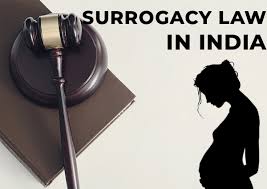Understanding India’s Surrogacy (Regulation) Act, 2021: A Journey Through Ethics and Law

For years, India stood as a prominent global destination for surrogacy, a phenomenon driven by lower costs, the availability of surrogate mothers, and an initially permissive legal environment. However, this largely unregulated landscape, while offering a path to parenthood for many, became increasingly fraught with ethical concerns, primarily the exploitation of economically vulnerable women and the lack of protection for children born through such arrangements. The Surrogacy (Regulation) Act, 2021, which came into force on January 25, 2022, marked a watershed moment, fundamentally reshaping India’s approach to surrogacy by moving towards a strictly regulated, altruistic model.
The Roots of Reform
The story begins in an era when India’s surrogacy scene operated with little oversight. The Indian Council of Medical Research (ICMR) issued guidelines in 2002, offering a semblance of legitimacy, but without enforceable laws, the industry grew unchecked. Clinics sprang up, surrogate mothers often from impoverished backgrounds signed up for meagre pay, and foreign couples flocked to India’s shores. By some estimates, the sector was worth billions annually. However, the lack of regulation soon cast a shadow over this success. Reports emerged of women housed in substandard conditions, pressured into repeated pregnancies, and left vulnerable to medical neglect. Children, too, suffered; some were abandoned when parents rejected them due to disabilities or personal disputes.
The journey towards comprehensive regulation was paved by growing concerns over “surrogacy consumerism” and the “baby factory” narrative. Reports highlighted inadequate medical care, insufficient compensation for surrogates, and the abandonment of children in some instances. The judiciary also played a critical role. Landmark cases like Baby Manji Yamada v. Union of India (AIR 2009 SC 84), involving a Japanese infant facing potential statelessness, and Jan Balaz v. Anand Municipality (2009 SCC Online Guj 10446), concerning the citizenship of twins born to a German father via an Indian surrogate, exposed the profound legal vacuums and human costs of unregulated cross-border surrogacy. These cases underscored the urgent need for laws to protect children’s rights, clarify legal parentage, and prevent the exploitation of surrogate mothers. The result? The Surrogacy (Regulation) Act, 2021, a bold attempt to curb exploitation, protect vulnerable parties, and impose ethical boundaries on a practice that had spiralled out of control.
Who Can Access Surrogacy?
At its core, the Act is restrictive, carefully defining who can participate in surrogacy. Intending parents must be a married Indian couple, the woman aged 23 to 50, the man 26 to 55; wedded for at least five years and unable to conceive naturally, as certified by a medical “certificate of essentiality.” Typically, they should have no surviving children, though exceptions exist for cases involving a disabled or critically ill child. Widows and divorcees aged 35 to 45 also qualify, albeit with specific rules about gamete use.
The Act however shuts the door on foreigners, Overseas Citizens of India (OCIs), single men, LGBTQ+ individuals, and unmarried couples, reflecting a traditional view of family that has drawn sharp criticism. It has also led to despair for those who have been shut out.
Surrogate mothers face equally tight criteria. They must be a “close relative” of the intending parents, aged 25 to 35, married, and already a mother to at least one child. They can surrogate only once, with a cap of three procedure attempts, and must pass medical and psychological evaluations. Intending parents are obligated to provide 36 months of health insurance to cover potential complications. While this “close relative” rule aims to keep surrogacy altruistic, it’s a double-edged sword; finding a willing family member who fits the bill is no small feat, and some worry it could subtly pressure relatives into agreeing.
A Framework for Oversight
To enforce its vision, the Act builds a robust regulatory system. National and State Assisted Reproductive Technology and Surrogacy Boards lead the charge, advising policymakers, setting standards, and keeping tabs on surrogacy clinics. Every clinic must register, boasting top-notch facilities and staff; gynaecologists, embryologists, and counsellors to ensure safe, ethical practices. A National Registry ties it all together, tracking clinics and procedures in a centralized database. This structure is a far cry from the free-for-all days of old, aiming to root out the shady operators that once thrived in the shadows.
Safeguarding the Children
Children born through surrogacy take center stage in the Act’s priorities. Legally, they’re recognized as the biological offspring of the intending parents, securing their inheritance and rights from day one. Abandonment is strictly forbidden, whether due to birth defects, multiple births, or any other reason. This focus on child welfare draws lessons from cases like Baby Manji Yamada, ensuring no child is left in limbo. By granting them the same status as naturally born children, the Act aims to erase the uncertainties that once plagued surrogacy arrangements.
Cracking Down on Violations
The Act doesn’t mince words when it comes to enforcement. Commercial surrogacy; paying a surrogate beyond medical and insurance costs, carries a penalty of up to 10 years in prison and a fine of Rs 10 lakhs. Exploiting surrogates, abandoning children, or dabbling in sex selection trigger similar punishments. Unregistered clinics face fines and jail time too. These stiff consequences signal the government’s resolve to dismantle the profit-driven model and uphold the Act’s ethical backbone.
Evolution Through Amendments
The Act hasn’t stood still since its debut. A key sticking point is the donor gametes (gametes are the reproductive cells of an organism) conundrum which has seen significant tweaks. At first, the rules were murky, but a March 2023 update required both gametes to come from the intending couple, effectively banning donors. That didn’t last long. Couples challenged it in court, and by January 2024, the Supreme Court stepped in, allowing donor eggs for medical necessity. A February 2024 amendment followed, permitting one donor gamete if a medical board approves, so long as the other gamete is from the couple. This back-and-forth reflects the Act’s growing pains, adapting to real-world needs while clinging to its emphasis on genetic ties.
The Courts Weigh In
India’s judiciary has long been a player in the surrogacy saga. Pre-Act cases like Baby Manji Yamada and Jan Balaz laid the groundwork for reform, shining a light on child welfare and parentage issues. Post-Act, the courts remain active, interpreting the law and tackling its limits.
In a recent judgement, the Kerala High Court, in Rajitha P.V. v. Union of India [WP(C) No. 403 of 2025], delivered a significant ruling on the interpretation of age limits for intending mothers. The Court held that a woman becomes ineligible for surrogacy on the day she completes 50 years of age, strictly adhering to the wording of Section 4(c)(i) of the Act. The Court dismissed arguments that eligibility should extend until the day before her 51st birthday, emphasizing that statutory age limits, set by the legislature considering biological factors, cannot be judicially altered.
A significant number of petitions currently before the Supreme Court such as the petition filed as Maheshwara M.V. v. Union of India (W.P.(C) No. 309/2025) and Dr. Arun Muthuvel v. Union of India (W.P.(C) No. 756/2022) deal with the issue of excluding single and divorced men from availing surrogacy and the overall constitutional validity of both the Surrogacy (Regulation) Act, 2021, and the Assisted Reproductive Technology (Regulation) Act, 2021 respectively. There are several other pending petitions which have been tagged together in these Petitions for comprehensive redressal challenge the Act’s restrictive eligibility criteria, which exclude various groups such as the LGBTQ+ from accessing surrogacy. The arguments in these petitions are typically grounded in fundamental rights, asserting that such exclusions violate Article 14 (Right to Equality), Article 19 (Fundamental Freedoms), and Article 21 (Right to Life and Personal Liberty), which has been interpreted to include reproductive autonomy, the right to found a family, and dignity.
This ongoing dance between lawmakers and judges keeps the Act in flux, refining it through legal scrutiny.
The Big Debate
The Act’s provisions have sparked lively arguments. The “close relative” rule, for instance, is a lightning rod; practicality aside, it raises ethical red flags about family dynamics and coercion. The commercial surrogacy ban divides opinions too: advocates say it stops exploitation, while detractors argue it strips women of agency and risks pushing the practice underground. The fertility industry feels the squeeze as well, with higher compliance costs and a drop in medical tourism hitting clinics hard. Overregulation might drive desperate couples to shady alternatives or foreign shores. Then there’s the emotional toll, altruistic surrogacy could bond families or strain them, depending on how it plays out, highlighting the need for strong support systems.
Looking Ahead
What’s next for the Act? The Courts will keep shaping it, especially as constitutional challenges unfold. The National and State Boards, alongside the National Registry, must stay vigilant to stamp out loopholes. Research into the Act’s social, economic, and emotional ripple effects will guide future tweaks. And public conversation about reproductive rights, family definitions, and ethical boundaries will nudge the law forward. The Act’s success hinges on its ability to adapt while staying true to its protective roots.
Final Thoughts
India’s Surrogacy (Regulation) Act, 2021, is a gutsy bid to tame a once-unruly industry, swapping commerce for compassion. It’s not perfect, its tight rules have sparked pushback, and its rollout has hit bumps. Yet, it’s a starting point, a framework striving to shield the vulnerable while navigating modern family realities. As courts, regulators, and society wrestle with its implications, one thing’s clear: the journey to balance ethics, rights, and practicality is far from over. What do you think does it go too far, or not far enough?
Sushila Ram Varma,
Advocate & Chief Consultant,
The Indian Lawyer & Allied Services
Assisted by Saharsh Singh,
Intern,
4th Year, National Law Institute University, Bhopal
Please log on to our YouTube channel, The Indian Lawyer Legal Tips, to learn about various aspects of the law. Our latest video, titled “Senior Citizens: Legal Rights & Support Systems Explained” can be viewed at the link below:
https://youtu.be/gWns2AXAAP8?si=jJubUQoDl56cDQV1





































Leave a Reply